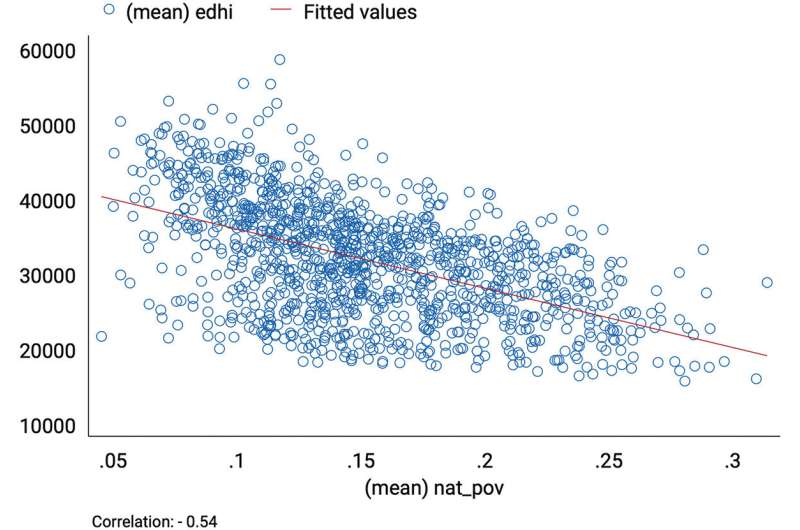Why it is more difficult to be poor in some states than others

Poverty rates vary between U.S. states as much as they do between European countries, a new study suggests.
Findings showed that in 2016, poverty rates in the European Union ranged from 6-16%—compared to 7-29% between U.S. states that same year.
There were also sizable differences between states in the risks of poverty—such as unemployment and single motherhood—as well as how much those risks translated into the probability that households would become impoverished.
One implication from the findings is that state policies play a pivotal role in how many of their residents live in poverty, said D. Adam Nicholson, author of the study and President's Postdoctoral Scholar in sociology at The Ohio State University.
"If poverty on the national level is to decrease, it likely must start with states," Nicholson said.
"Some states are much more successful than others in minimizing the risks associated with poverty and the penalties that come for those who carry those risks."
The study was published online recently in the journal The Sociological Quarterly.
Nicholson used data from the 1993-2016 Annual Social and Economic Supplement of the U.S. Census Bureau's Current Population Survey, supplemented with other data to improve income estimates. Overall, 3.5 million people were sampled over the 24 consecutive years.
For this study, poverty was defined as living in a household with less than 50% of the national median equalized disposable income.
Results showed that, over the 24 years, the poverty rate in the poorest state (Mississippi) averaged 24.3%—more than 3.5 times higher than the 6.6% average rate in New Hampshire, which was the lowest.
One key to understanding how many people live in poverty is seeing how many residents in a state have one or more of four common risks that often push people below the poverty line: low education, single motherhood, unemployment and having a lead earner under 25 years old.
As expected, states with more residents who have one or more of those risks tended to have more people in poverty. On average, one in three people in the U.S. has at least one of these risks.
But in high-poverty Mississippi, 42% of residents had at least one of the four risks, compared to 25% in low-poverty New Hampshire.
States not only vary in the prevalence of risk, but also in the penalties associated with those risks, Nicholson said. Penalties are the probability that any of the risks will actually push a person into poverty.
And the penalties varied widely, results showed. An individual with all four risks would almost certainly experience poverty in Alabama (over 92% probability), while fewer than 25% of individuals with all four risks in Hawaii would expect to be poor.
"Poverty in some states may be driven by a high prevalence of risk, while in others it may be driven by high penalties," Nicholson said. "That's why it is important to study poverty at the state level and not just the national level."
Changes in some trends identified in the study may be associated with the notable federal welfare reforms in 1996 which allowed states to impose work requirements and other policies that could restrict aid to those at risk of poverty.
For example, after the welfare reforms, the variation in the single motherhood penalty across states more than doubled, results showed. "The penalties for single mothers differ a lot depending on the state where they live," Nicholson said.
The penalty for unemployment varied the least among the states, but it is the highest by far, making it the most consequential risk for poverty. And the penalty has increased over time, the study showed.
"This supports arguments that work requirements attached to welfare benefits may have important implications for poverty levels," he said.
Race and ethnicity of residents undoubtedly play a key role in the variation in poverty levels between states, and in how states respond to poverty risks, Nicholson said. He will focus more on this issue in a future study.
Overall, the results suggest that one way to help reduce poverty in the United States would be for states to mimic policies in their counterparts that have done the best at lowering risks and penalties.
If the prevalence of poverty risks in the U.S. matched the lowest prevalence found across states, and the average penalties matched the lowest penalties at the state level, then the U.S. poverty rate would be nearly 5 percentage points lower than it was in 2020, Nicholson said.
"That percentage may seem small, but it translates into between 11 and 16 million people being moved out of poverty," he said. "That would be a huge success."
More information: D. Adam Nicholson, Poverty, Prevalences, and Penalties in U.S. States, 1993-2016, The Sociological Quarterly (2022). DOI: 10.1080/00380253.2022.2123412
Journal information: Sociological Quarterly
Provided by The Ohio State University





















